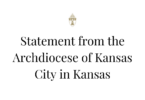by Marc and Julie Anderson
mjanderson@theleaven.org
TOPEKA — Pastoral priorities. Regional demographics. Strategic planning.
Father Greg Hammes, pastor of Most Pure Heart of Mary Parish in southwest Topeka, admitted he was a bit intimidated by the process when the parish first began developing its strategic pastoral plan.
But now that the process is completed, Father Hammes said he’s convinced it will provide a vision and direction for the parish.
“It’s going to really bless us in so many ways,” he said.
Father Hammes, some 20 parishioners and Steve Ehart, the consultant for the archdiocesan office of mission strategy, met June 2 to present the parish’s strategic pastoral plan for the upcoming year.
Most Pure Heart of Mary Parish is one of four parishes in the Topeka region to either recently start or complete the planning process. The other three parishes are Our Lady of Guadalupe, Mater Dei and St. Matthew. The parish plans are designed to support and help implement within the parish the regional pastoral plan and the archbishop’s 10-year vision for the archdiocese.
Opening the meeting, Father Hammes read the parable of the talents, after which he likened the parish and its members to those in the parable. Most Pure Heart of Mary Parish has approximately 1,650 families, he said, and the newly crafted pastoral plan will utilize best practices and harness all of the parish’s resources.
“We’ll put it to work and make it grow,” said Father Hammes. “We’ll be a parish of joy.”
The pastoral plan will be updated regularly, Ehart said, perhaps even annually. Its most important feature is that it provides specific, tangible tasks and objectives, all within the framework of “growing disciples for Jesus.”
“I’m 100 percent confident that you’re going to get incredible results out of this,” Ehart told those gathered, adding the plan reflects the synthesis of the best thoughts of parishioners.
The plan consists of five main parish goals, all of which identify specific action steps — to be taken by specific parish staff, parishioners or committees — with accompanying specific timelines for completion.
For example, the first goal — that of pastoral priorities — reads as follows: “To provide focus and improvement on five pastoral priorities through purposeful planning and execution. This includes conversion, evangelization, all forms of Catholic education, social concerns and stewardship.”
Specific goals under the main goal include developing, implementing and strengthening a more intentional prayer ministry; increasing awareness, interest and participation in perpetual adoration; and increasing awareness and importance of Catholic education to parishioners and the broader community.
Tasks under each subgoal might be simple or complex, depending on the goal. For example, under the prayer ministry goal, one task or objective reads: “Make prayer intention cards available at Mass” and assigns to the task a specific completion date of later this summer.
The parish planning process began Feb. 24 with a kickoff meeting, after which nine separate teams of parishioners were formed to study and research various areas of parish life, including evangelization efforts, physical facilities, education and outreach.
Working with parishioners, Ehart emphasizes, is absolutely vital to the ultimate success of the parish’s strategic plan.
“Each parish is unique,” he said, and a one-size-fits-all plan would not take into consideration the specific needs and characteristics of the parish.
Father Hammes said the parishioners’ collaboration not only highlights the parish’s uniqueness, but it also means the plan is immensely better than anything created by only a handful.
“It’s really going to bear fruit,” he said.






